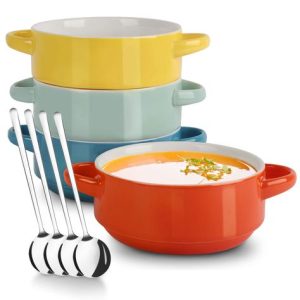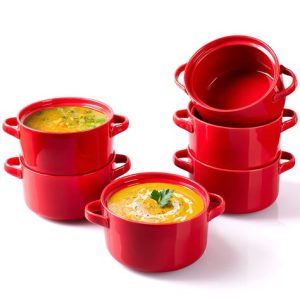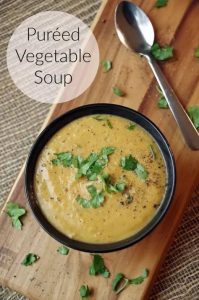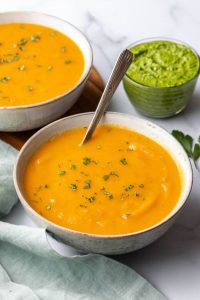How to make puree vegetable soup? Pureed vegetable soup is a creamy, comforting dish that’s perfect for people of all ages. It’s a fantastic way to sneak in extra veggies and can be customized with your favorite flavors.
This article will guide you through everything you need to know about making delicious and healthy pureed vegetable soup at home.
Gathering Your Ingredients
Pureed vegetable soup is a versatile dish. There’s no single right ingredient list! However, some common vegetables used in puree soups include:
- Potatoes
- Carrots
- Onions
- Celery
- Broccoli
- Cauliflower
- Peas
- Corn
- Zucchini
- Tomatoes
Here are some additional things you might need:
- Vegetable broth or stock
- Olive oil or butter
- Garlic cloves
- Herbs and spices (optional)
- Salt and pepper to taste
Tip: When choosing vegetables, aim for a variety of colors to ensure a well-rounded nutrient intake.

Simple Steps to Creamy Soup Perfection
Here’s a basic roadmap for creating your own delectable puree vegetable soup:
Prep your vegetables:
Wash and chop your vegetables into similar-sized pieces. This ensures even cooking.
Sauté the aromatics (optional):
Heat olive oil or butter in a large pot or Dutch oven. Sauté onions, garlic, or other aromatics until softened.
Add vegetables and broth:
Add your chopped vegetables and vegetable broth to the pot. Bring to a boil, then reduce heat and simmer until the vegetables are tender.
Puree the soup:
Once the vegetables are tender, there are two ways to puree the soup:
-
- Using an immersion blender: This handy tool lets you puree the soup directly in the pot. Simply blend until you reach your desired consistency.
- Using a blender or food processor: Transfer the cooked vegetables and broth to a blender or food processor. Blend until smooth, then return the soup to the pot.
Season and adjust:
Add salt and pepper to taste. You can also add your favorite herbs and spices at this point. For an extra creamy texture, stir in some milk, cream, or even mashed avocado.
Serve and enjoy!
Ladle your creamy puree vegetable soup into bowls and garnish with fresh herbs, a drizzle of olive oil, or a sprinkle of cheese (optional).

Adding Variations and Personal Touches
The beauty of puree vegetable soup is its adaptability! Here are some ideas to personalize your creation:
-
Change up the veggies: Experiment with different vegetables based on your preferences and what’s in season.
-
Spice it up: Add a kick of heat with red pepper flakes, chili powder, or your favorite hot sauce.
-
Go global: Draw inspiration from different cuisines. For example, add a dollop of curry paste for a Thai twist or top your soup with a swirl of pesto for an Italian touch.
-
Make it creamy: For an extra dose of creaminess, add some milk, cream, or even mashed avocado before blending.
-
Top it off: Get creative with toppings! Chopped fresh herbs, a dollop of Greek yogurt, a drizzle of balsamic glaze, or toasted nuts can all add flavor and textural interest.
Tips for Making Perfect Puree Vegetable Soup
Here are some extra pointers to ensure your puree vegetable soup turns out delightful:
-
Use ripe vegetables: Ripe vegetables will have the best flavor and texture in your soup.
-
Don’t overcook the vegetables: Overcooked vegetables can become mushy and lose their vibrant color. Aim for tender-crisp.
-
Control the thickness: The amount of broth you add will determine the consistency of your soup. If your soup seems too thick, simply add more broth a little at a time until you reach your desired texture.
-
Taste as you go: Seasoning is key! Don’t be afraid to taste your soup throughout the process and adjust the salt, pepper, and herbs to your liking.

Beyond the Pot: Serving and Storage Options
Puree vegetable soup is a versatile dish that can be enjoyed hot or cold. Here are some tips for serving and storing:
-
Hot or Cold: Puree vegetable soup is delicious served hot or chilled. On a hot day, a bowl of chilled puree soup can be refreshing.
-
Bread Pairings: Pair your soup with crusty bread, crackers, or breadsticks for dipping.
-
Leftovers: Puree vegetable soup stores well in the refrigerator for up to 3 days. Reheat gently in a pot on the stovetop over low heat.
-
Freezing Option: You can also freeze leftover puree vegetable soup for longer storage. Let the soup cool completely, then transfer it to airtight freezer-safe containers. Frozen puree vegetable soup will generally stay good for up to 3 months.
-
Puree vegetable soup is a healthy, delicious, and versatile dish. It’s a fantastic way to sneak in extra veggies and can be customized with your favorite flavors. With a little creativity, you can create endless variations of this comforting soup. So grab your favorite vegetables, and get ready to enjoy a delightful bowl of homemade goodness!

Building Flavor with Broths and Stocks
Vegetable broth or stock adds depth of flavor to your puree soup. Here are some things to consider:
-
Store-bought vs. Homemade: Both store-bought and homemade vegetable broths can be used. Look for low-sodium options if using store-bought broth.
-
If you’re feeling adventurous, try making your own vegetable broth for an extra flavor boost! There are many online recipes available for homemade vegetable broth.
-
Flavor Variations: Consider different broths or stocks to add unique flavor profiles. For example, chicken broth can add a savory richness, while mushroom broth can add an earthy depth.
The Power of Herbs and Spices
Herbs and spices can take your puree vegetable soup from bland to grand! Here are some ideas:
-
Fresh vs. Dried: Both fresh and dried herbs can be used. Fresh herbs tend to have a brighter flavor, while dried herbs offer a more concentrated taste.
-
Classic Combinations: Some classic herb combinations for vegetable soup include parsley, thyme, and rosemary.
-
Global Inspiration: Draw inspiration from different cuisines for unique flavor profiles. For example, a pinch of curry powder can add a warm, Indian-inspired touch.
Don’t be afraid to experiment and find your own favorite herb and spice combinations!

Beyond the Basics: Adding Protein and More
While puree vegetable soup is delicious on its own, you can also add other ingredients to boost its nutritional content:
-
Protein Powerhouses: For an extra protein punch, consider adding cooked lentils, chickpeas, or shredded cooked chicken.
-
Healthy Fats: A drizzle of olive oil or swirl of pesto can add healthy fats and extra flavor.
-
Creamy Dream: For an extra dose of creaminess, consider adding some milk, cream, or even mashed avocado before blending.
These are just a few ideas to get you started. Get creative and personalize your puree vegetable soup to your liking!
